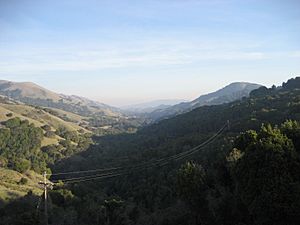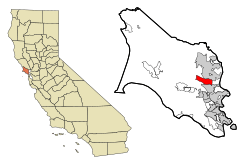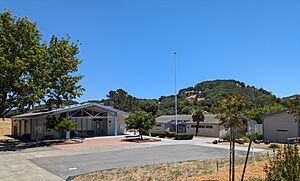Lucas Valley-Marinwood, California facts for kids
Quick facts for kids
Lucas Valley-Marinwood, California
|
|
|---|---|

Lucas Valley
|
|

Location in Marin County and the state of California
|
|
| Country | United States |
| State | California |
| County | Marin |
| Area | |
| • Total | 5.731 sq mi (14.84 km2) |
| • Land | 5.731 sq mi (14.84 km2) |
| • Water | 0 sq mi (0 km2) 0% |
| Elevation | 620 ft (189 m) |
| Population
(2020)
|
|
| • Total | 6,259 |
| • Density | 1,092.13/sq mi (421.67/km2) |
| Time zone | UTC-8 (PST) |
| • Summer (DST) | UTC-7 (PDT) |
| ZIP code |
94903 (San Rafael)
|
| Area codes | 415/628 |
| FIPS code | 06-44399 |
| GNIS feature ID | 2408149 |
Lucas Valley-Marinwood is a community in Marin County, California, United States. It's known as a "census-designated place" (CDP). This means it's an area identified by the government for collecting statistics, but it's not an officially incorporated city or town. The area includes the neighborhoods of Lucas Valley and Marinwood. In 2020, about 6,259 people lived here.
Contents
History of Lucas Valley-Marinwood
The history of Lucas Valley-Marinwood goes back a long way. In 1844, a man named James Miller, who was from Ireland, traveled to California. He arrived in San Rafael in 1845.
Early Land Ownership and Development
In 1846, James Miller bought about 680 acres (2.75 square kilometers) of land. This land included what is now Marinwood and a creek, which was later named Miller Creek. He rebuilt an old adobe house on a hill and called it Miller Hall.
By 1862, James Miller had 10 children. In 1864, he gave a small piece of land (about three-quarters of an acre) next to Miller Creek. This land was used to build the Dixie School. The original school building is still around today. It has been moved in front of Miller Creek Middle School and is listed on the National Register of Historic Places.
James Miller passed away in 1890. His large ranch, which was about 1,084 acres (4.39 square kilometers), was sold to the Sequeira family in 1935. They tore down Miller Hall that same year.
Farming and Dairy Operations
A part of James Miller's land was sold to Anthony Faustine (A.F.) Silveira. He had been renting the property from 1900 to 1935. In 1935, Silveira built his own home and a dairy farm on the east side of what is now Highway 101. Silveira was the first president of Marin Dairymen's Milk Co. Ltd., also known as Marin-Dell. He died in a farm accident in 1937. His family continued to run the ranch, and it still operates today.
Naming of Lucas Valley
Lucas Valley got its name from John Lucas. He was a rancher in the 1800s and was the nephew of Timothy Murphy, an early land owner. It's important to know that John Lucas is not related to the famous filmmaker George Lucas.
Modern Homes and Neighborhoods
In the 1950s and 1960s, the area started to grow with new homes. A famous builder named Joseph Eichler helped create many of these modern homes. His unique and stylish houses can be found throughout Lucas Valley and Eastern Marinwood. Eichler also built the Lucas Valley community center and pool, which became a central part of the neighborhood.
The first part of Marinwood to be developed had streets with names ending in "-stone." These include Adobestone, Blackstone, and Windstone. A second, smaller area was built later, with streets like Pinewood and Quietwood, ending in "-wood."
Later, an area known as Lower Lucas Valley was developed. This area featured the Eichler-style homes. The streets here were named with "-berry" at the end, such as Appleberry, Cedarberry, and Newberry. The final development was Upper Lucas Valley, located further west. Its streets are named after famous mountains like Mt. Shasta and Mt. Rainier.
In 1977, George Lucas bought about 1,267 acres (5.13 square kilometers) of land west of Marinwood. He turned this land into Skywalker Ranch. Skywalker Ranch is on the western side of Big Rock Ridge and is not part of the Lucas Valley-Marinwood community itself.
Geography of the Area
Lucas Valley-Marinwood covers about 5.7 square miles (14.8 square kilometers) of land. It doesn't have any water within its borders. To the north, it borders the city of Novato. To the south, it borders San Rafael.
The U.S. Route 101 freeway forms the eastern edge of the community. Lucas Valley Road marks the southern border. The community stretches west along Lucas Valley Road up to the highest point at Big Rock.
Community Population and Demographics
Understanding the population helps us learn about the people who live in Lucas Valley-Marinwood.
Population in 2010
According to the 2010 United States Census, Lucas Valley-Marinwood had a population of 6,094 people. Most of the people (about 85.7%) were White. About 7% were Asian, and 1.1% were African American. People of Hispanic or Latino background made up about 7.3% of the population.
Most people (98.6%) lived in homes, not in group living situations. There were 2,348 households in total. About 34.5% of these households had children under 18 living there. The average household had about 2.56 people.
The population included people of all ages. About 23.9% were under 18 years old. About 20.1% were 65 years or older. The average age in the community was 47.3 years.
Most homes (85.3%) were owned by the people living in them. The rest (14.7%) were rented.
Population in 2000
In the year 2000, the population was 6,357 people. There were 2,369 households. About 37.4% of households had children under 18. The average household size was 2.64 people.
The population was spread out by age. About 26.6% were under 18. About 15.8% were 65 or older. The average age was 43 years.
Education in Lucas Valley-Marinwood
The schools in Lucas Valley-Marinwood are part of two main school districts. The Miller Creek Elementary School District (which used to be called the Dixie School District) covers elementary and middle schools. The San Rafael City High School District covers high schools.
Local Schools
There are three elementary schools in the area:
- Lucas Valley Elementary School
- Mary E. Silveira Elementary School
There is also one middle school:
- Miller Creek Middle School Panthers, which is recognized as a California Distinguished School.
For high school, students can choose to attend either San Rafael High School or Terra Linda High School.
See also
 In Spanish: Lucas Valley-Marinwood para niños
In Spanish: Lucas Valley-Marinwood para niños



